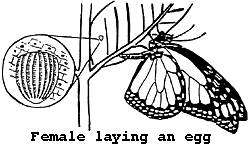
Life Cycle of the Monarch Butterfly

Monarch butterfly eggs are somewhat difficult to find in the wild. Since it only takes 3-5 days for eggs to hatch, timing is crucial. The best sign is to watch for adult monarchs stopping at milkweed plants. A female will usually only lay one egg per milkweed plant to ensure enough food for each larva. The egg is usually laid on the underside of the leaf, and females prefer young plants.


Each butterfly egg is surrounded by a hard, outer shell called a chorion, to protect the developing larva. The shell is lined with a layer of wax, which helps keep the egg from drying out. Each egg has one to many tiny funnel-shaped openings at one end, called micropyles. Since eggs get their hard shells before they are fertilized, this hole, which penetrates all the way through the shell, allows sperm to enter. The raised areas on the egg shell are called ridges. They are formed inside the female before she lays the egg. Butterfly and moth eggs vary greatly in shape. The top of the egg darkens just before the larva emerges.
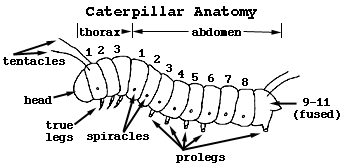
Larva have 3 distinct body parts: head, thorax and abdomen. The head has a pair of short antennae, mouth parts and 6 pairs of very simple eyes. The antennae and mouth parts (sensory organs), guide the caterpillar to its food; because even with so many eyes-- it has very poor eye sight!
The thorax has 3 pair of true legs. Five pairs
of prolegs (false legs) are located on the abdomen-- and have
hooks for holding the larva to surfaces. Like other insects,
monarch larva breathe through holes called spiracles, on the
sides of the thorax and abdomen. These spiracles are connected to
a network of long airtubes called tracheae, which carry oxygen
throughout the body. 
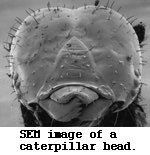
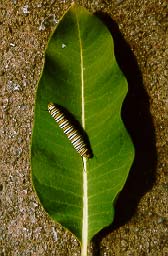

The monarch caterpillar (larva) is distinctively striped and easily recognizable, as it eats its way from one milkweed leaf to another. As it grows, it goes through a series of molts, shedding its exoskeleton as it grows.
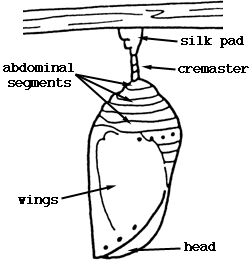
When it pupates, a monarch larva, splits its exoskeleton and wiggles out of its larval skin. When this skin moves far enough down the body, the cremaster appears. The cremaster is a spiny appendage at the end of the abdomen. The monarch hooks its cremaster into a silk pad spun by the larva just before it pupates. It will hang from this until it emerges as an adult. This freshly exposed pupa is very soft and delicate until it hardens. You can see many different body parts on the pupa, including: wings, abdomen, legs and eyes.

The adult monarch will emerge in 10-14 days. When it is ready to emerge, the adult wings will be visable through the pupa covering.





Adults usually emerge in the mid-morning. The newly-emerged adult takes 3-4 hours for its wings to dry.
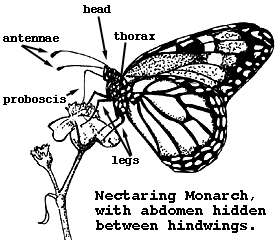
The body of the adult butterfly has the same 3 body parts as the larval stage did. The four main structures on the adult's head are: enormous compound eyes- for sensing light and images, antennae and palpi which provide the sense of smell, and the straw-like proboscis which is the "tongue" for drinking nectar and water. When not in use, it is curled up.
The thorax is made up of 3 segments, each with a pair of legs attached to it. The second and third segments have a pair of wings attached to them, as well. At the end of each leg, is a tarsus, which grips the vegetation. Organs for tasting sweet liquids are also located on the tarsi.
All butterflies and moths have 4 wings- 2 hindwings and 2 forewings. They move by muscles and by changing the shape of the thorax. Wing veins contain trachae, nerves and space for "blood" to move through. Veins give the wings structure, strength and support.
The abdomen consists of 11 segments, the last 2 of which are joined. On male monarchs, you can see a pair of claspers on the end of the abdomen. Their function is to hold the female during mating.